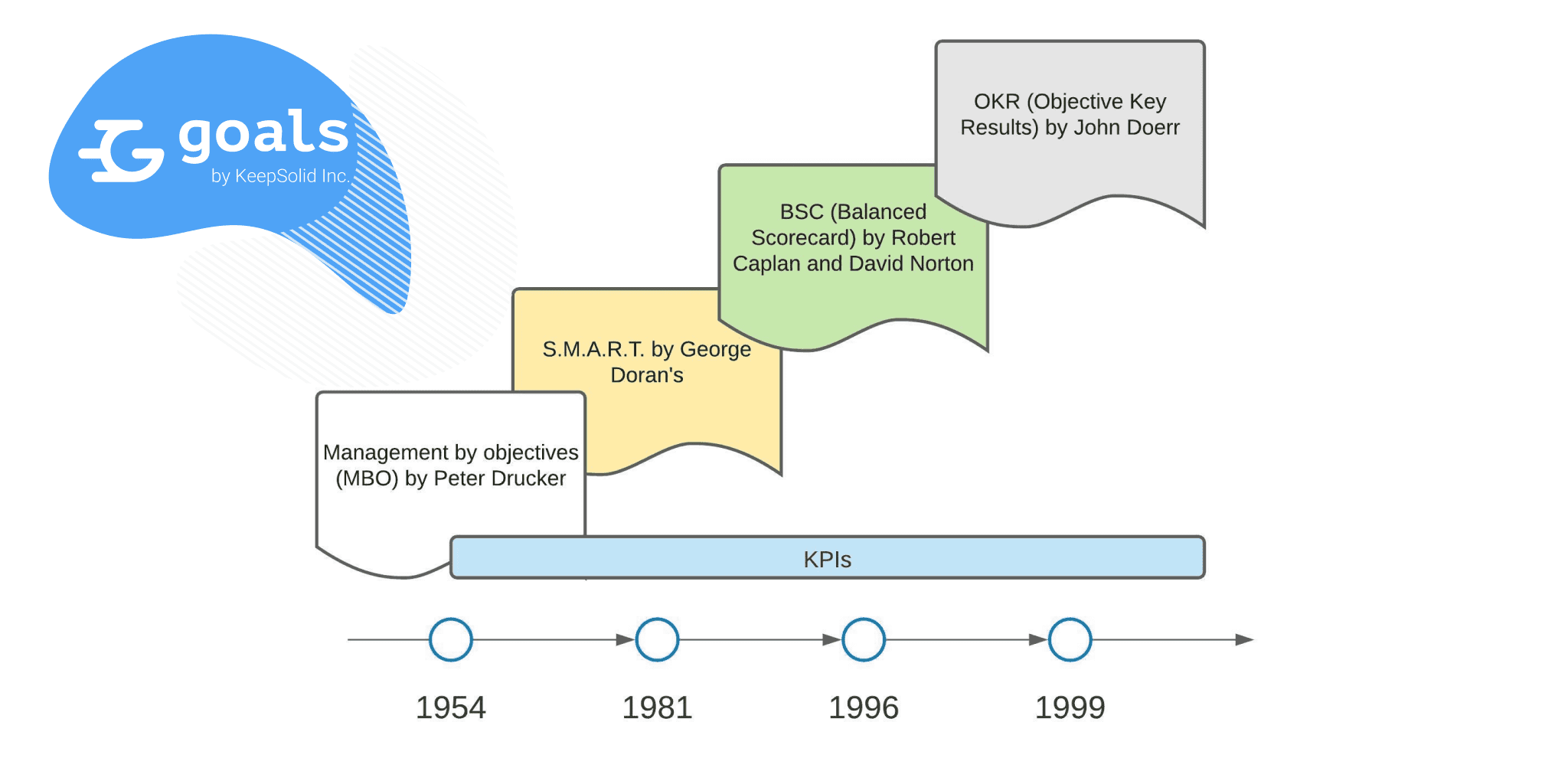In business, there are lots of practices, concepts, and terms that are easy to get confused about. MBO, KPI, BSC, OKR, SMART, etc. - all of these practices were created to help companies achieve their goals.
In an attempt to find the best frame and board the hype train, you may stumble upon some unusual comparisons, for example, OKR vs SMART or KPI vs BSC. In this piece, we at KeepSolid Goals team will try to make sense of all these methods and help you figure out the whats and whys.
It's All About Decision-Making in Business
Everything that is happening now is a consequence of decisions that were, or weren’t made. It makes sense to assume that there should be the best solution for any problem situation. The criterion for such a decision is the mission and strategic goals of the company.
The question then is: how to make correct decisions?
It is important to distinguish between reliable prediction and guesswork. For this, on the one hand, we need techniques and practices that help determine the causes of events. On the other hand, to make decisions we also need empirical baseline data.

For example, a company that was growing at 5% per year decides to grow by 30%. This is 6 times more than it has managed so far. Such growth cannot be a simple extrapolation of past experience. New approaches and solutions are needed.
Thus, everything related to decision making in business can be divided into two parts:
- business measurement system
- management of the business
Measurement in Business
Historic reference
Humanity had been trying to measure the result long before the appearance of the numeral system (3100 BC). The first mention of the application of what we now call KPI dates back to the 3rd century AD (221-265). In ancient China, the Wei Dynasty emperors evaluated the official qualities of family members using 9 grades.
The use of KPIs in the industry was most likely pioneered by Robert Owen, an English philosopher, educator, and one of the first social reformers in the early 1800s. Worker behavior would be recorded by supervisors using diagrams (called "silent supervisors") - wooden planks of different colors. At the end of the day, they would display the planks of the color that corresponded to the assessment of work and behavior of the worker for everyone to see.
The now-widespread SMART method of formalizing goals is associated with the names of George T. Doran and Paul J. Meyer. There is evidence that Paul J. Meyer used the term SMART in his work, the training text Personal Success Planner, in 1965.

Mr. Doran believed that ideally, every company and department should have a goal formulated according to the SMART model. He said sensible things and was far from dogmatism. For example, he said that not everything worth achieving can be measured, and the goal that you set for yourself does not require approval.
There are different ways to expand the abbreviation SMART. Mr. Doran in 1981 transcribed it like this:
- Specific - target a specific area for improvement
- Measurable - quantify or at least suggest an indicator of progress
- Assignable - specify a specific employee
- Realistic - describe what results can be realistically achieved given the resources
- Time-related - indicate when the result can or should be achieved
Goals of Measurement in Business
Measurements alone do not solve anything. It is simply a tool that quantitatively describes a piece of reality from a particular perspective.
For example, what can the MAU (Monthly Active Users) indicator that “decreased by 10%” tell us on its own? What decisions can we make based on this figure? The only correct answer is: we need to dig deeper, we need reasons!
When conducting an analysis, it may turn out that, for example, the app’s MAU has even increased on mobile devices, but seriously sagged on desktop devices. Or that this period is “not the season” for our product, and there is nothing to worry about.

Measurements should never be an end in themselves, they are a tool for making decisions, which in turn will or will not lead the team to the goal. The metric value tells us what happened, but it doesn't tell us the reasons or what to do about it. A company must move from measurement to management to take action.
How to evaluate the business value of measurements? Quite simply, the metrics management process should allow for accurate decision making and further positive change, and that's about it.
Management
Procurement Executives' Association defines management as “the use of measurement information to effect positive change in organizational culture, systems, and processes, by helping to set agreed-upon performance goals, allocating and prioritizing resources, informing managers to either confirm or change current policy or program directions to meet those goals, and sharing results of performance in pursuing those goals.”
While the task of the measurement process is to collect as accurate information as possible, the task of the management phase is to turn information into solutions. Namely, into those solutions that can affect the measurement system itself:
- goals can be changed
- the values or the metrics themselves can be changed
- methods of collecting information can be changed, etc.
The whole history of the development of the approaches mentioned at the beginning of the article is an attempt to solve the problem of the reliable achievement of goals. Which means:
- correctly identify the key factors that affect the achievement of goals
- achieve the realistic correspondence to the real state of affairs
- be able to align goals with each other at different organizational levels
- effectively communicate goals to employees
- solve the issue of flexibility and change "on the fly"

MBO
Management by Objective (MBO) or management by results has been invented a long time ago. Peter Drucker popularized this model in his 1954 book The Practice of Management. The method was further developed by Drucker's students in the mid-1960s. Many companies (e.g. Hewlett-Packard) have since employed this management system.
MBO requires managers and employees to identify and agree on specific company objectives and then decide what actions to take to consistently achieve each objective.
MBO establishes a common framework for managers and their subordinates, allows them to define the areas of responsibility of each employee and track their performance along the way. All that - to achieve the common objective. Measuring an employee's actual performance against their objectives is an important part of MBO.
BSC
In 1996, R. Kaplan and D. Norton published The Balanced Scorecard: Translating Strategy into Action. In this book, they discussed performance measurement and leading and lagging indicators. But by 2000, when they published The Strategy Focused Organization, they had further explored the concept of performance management. They said that simply having a set of measures was not enough; organizations needed to have a process for evaluating, responding, and agreeing on these measures to put them into action.
What is performance measurement?
Performance measurement deals specifically with performance metrics. These are quantitative indicators that you set to track the progress of your strategy. Good performance indicators usually cover a wide range of criteria, for example:
- Financial
- Customer or marketing
- Processes
- Personnel and training
These aspects will let you know if you are on the right track to achieving your strategy and goals. This is incredibly useful information - you can base great reports on it and share those reports with your organization. But this is not enough, as we can see if we look at performance management.
What is performance management?
While performance measurement asks the question, “What do we track when moving towards the goals?”, performance management asks, “What should we do, what decisions should we make to reach the goals?” This is a subtle but very important distinction.
OKR
Objectives and Key Results (OKR) is the new kid on the block. Even though OKRs were developed most recently, they quickly gained prominence thanks to Google’s support.
OKRs were originally developed by Andy Grove, who introduced this concept to Intel during his time at the company. Then, in 1999, OKRs were introduced to Google by John Doerr. The company continues to use this method even today.

Besides Google, other companies use the OKR goal-setting technique, including Spotify, Twitter, LinkedIn, Airbnb, and even Target and ING Bank.
By default, OKR consists of two components:
- Objective - a detailed description of what the company wants to achieve.
- Key Results - milestones with measurable values to measure progress
While MBO and BSC methods focus on being realistic and taking into account currently available resources, OKRs do not require precision in achieving goals. If an Objective is 80% fulfilled - this can be considered an excellent result. This method aims to encourage teams and individuals to think outside the box and be ambitious.
The OKR approach is considered to be more flexible because the timelines set using it are generally dynamic. OKRs are implemented from the bottom up, and the Objectives of each department should align with the overall goals of the company. Everyone is well aware of how their contributions can affect the overall business performance - implementing OKRs can increase transparency.
It's worth noting that OKRs are not a checklist for every task that must be done. Instead, OKRs help companies identify top priorities that need immediate attention. One of the common mistakes that businesses often make when first defining OKRs is setting too many Objectives and Key Results at once. Others see OKRs as a “New Years Resolution” - they set Objectives and Key Results but fail to achieve them.
Conclusion
The main purpose of a measurement system in business is to furnish a language for describing expectations. The language of metrics allows you to results. The team can discuss and, more importantly, agree among themselves on the current results and move on to work on the reasons and plans.

Like any other language, the measurement language has its limitations:
- Any language limits the possibilities of describing reality, it is never completely accurate
- Language greatly simplifies reality by reducing its diversity to the closest concepts
- Many important things in business are difficult to measure. Think about leadership, communication quality, etc
- Interpreting metrics is a very subjective process. As economist J.K. Galbraith once wrote, “Faced with a choice between changing one’s mind and proving there is no need to do so, almost everyone gets busy with the proof.”
As for the management system, it should evaluate in real time the efforts and decisions made on the way to goals. The task of management is to improve the organization with each decision taken, to increase its potential, capabilities, and sustainability. Another task - is to develop the ability to make accurate decisions.
The whole history of the development of goal achievement is the search for a more accurate way to describe the result. It’s also the search for a better decision-making method, including planning and change management. And this search continues.



